The Risks of Fastening Near the Edge of a Masonry Unit
We thought the title of today’s blog article was a bit funny because it seems like such an obvious concept yet people seem to do it wrong all the time. Even though it sounds obvious to the point of being silly, we thought it’d be better to explain it here on our blog so the public should read it and learn. The simple concept is that it’s bad to install a fastener such as a nail or a screw into a brick near the edge of a brick. Inherently, brick, concrete, and most types of masonry and stone have a relatively high compressive strength resistance capacity or capability. Those same elements of concrete or masonry though generally lack a different type of structural strength resistance called tensile strength.
The next two pictures below show two different locations at the front facade of a building here in Washington dc. Two different pairs of Fasteners were installed directly into the brick faces of this front facade. They were installed so many years ago that we’re not sure the purpose of the fasteners. In this case, these Fasteners are under a front porch overhang so at least they will last longer before they oxidize. Oxidation of fasters, installed anywhere in masonry, is a relatively big problem because when a ferrous metal fist or oxidizes, it will expand greatly with significant Force which will generally cause masonry to break and crack apart.
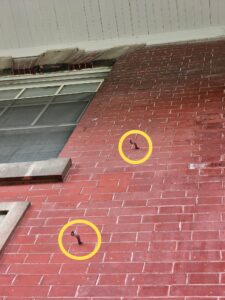
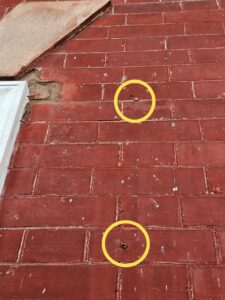
The picture Belushi is an example where a screw was installed into the mortar joint. We think it’s much better to install fasteners into the mortar joints, instead of directly into the face of a brick.
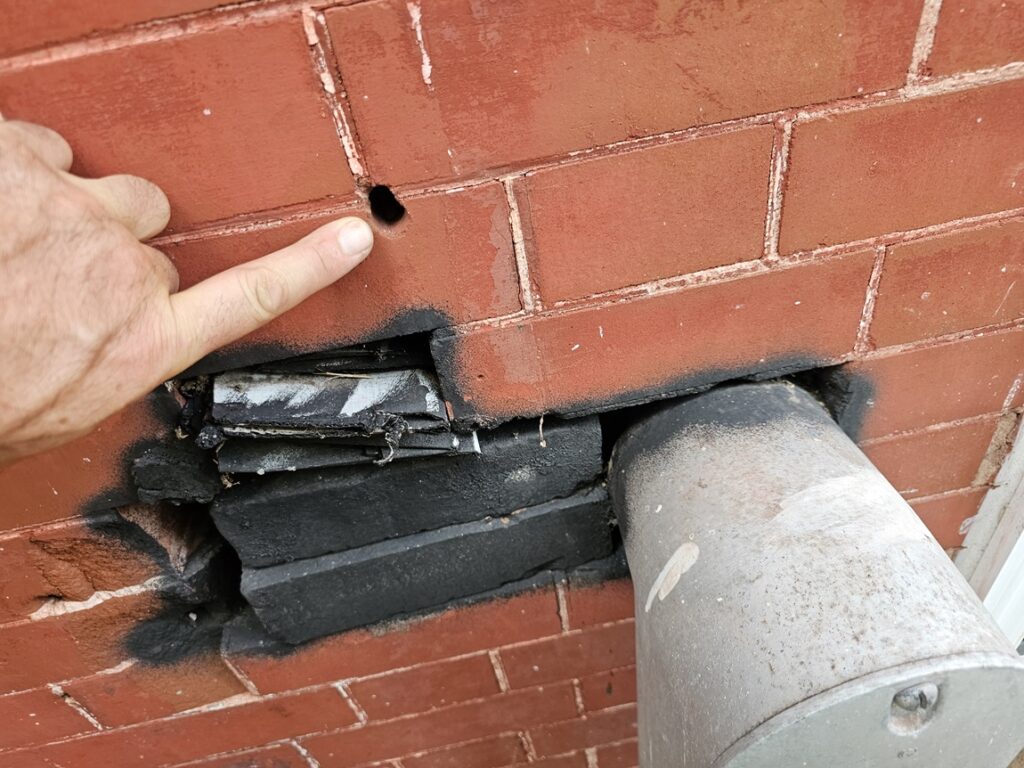
Installing a fastener like a screw or nail into the face of a brick, particularly near the edge, is a poor practice because it can cause the brick to crack or break due to the inherent structural properties of masonry materials. Bricks are strong in compression but weak in tension and shear. When a fastener is driven into the face of a brick, especially near its edge, the localized stress introduced by the fastener exceeds the tensile and shear strength of the brick material. This stress creates a concentration of forces that the brick, due to its brittle nature, cannot distribute effectively, leading to cracking or even complete failure of the brick.
Bricks are composed of clay or other ceramics that are fired at high temperatures to achieve their strength. However, this strength is mostly aligned with compressive forces—those that push inward. When forces act to pull apart or shear the material, such as the outward force from driving in a fastener, the brick material is unable to handle the strain, especially when the fastener is near an edge where the material’s ability to distribute stress is even more limited.
The edges of bricks are particularly vulnerable because they have less material to absorb and distribute the forces. When a fastener is driven into the edge, the stress is concentrated in a small area, increasing the likelihood of cracking. This is due to the lack of reinforcement within the brick itself—bricks don’t have fibers or reinforcement bars to resist these forces, as some other materials might. Once the edge of the brick cracks, the structural integrity of the entire wall or structure can be compromised, leading to more extensive damage and potentially expensive repairs.
In contrast, installing fasteners into the mortar joints between bricks is generally safer and more effective. Mortar, a mixture of cement, lime, sand, and water, is designed to be somewhat more flexible and accommodating than brick, making it better suited to handle the forces exerted by fasteners. Mortar joints also distribute the stresses introduced by the fastener more evenly across the brickwork, reducing the risk of cracking. Mortar is also easier to repair than brick; if a mortar joint is damaged by a fastener, it can be re-pointed or patched more easily than replacing an entire brick.
Additionally, mortar joints provide a more forgiving medium for adjustments. If the fastener needs to be removed or replaced, the damage to the mortar can be repaired without affecting the integrity of the bricks themselves. This flexibility is particularly important in maintaining the long-term durability and aesthetics of a brick structure.
In summary, to avoid damaging bricks and compromising the structural integrity of a masonry wall, it is better to install fasteners into mortar joints rather than into the face of bricks. The tensile and shear weaknesses of bricks, especially near edges, make them susceptible to cracking under localized stress, whereas mortar joints can better absorb and distribute these forces, ensuring a safer and more durable installation.
The next picture below shows screw anchors that were installed into the face of a historic brick. Even without seeing more of the greater expanse of the wall, just looking at this small area you can tell that it’s historic brick because of the fine motor joint. It’s not just a historic common brick but in this case a historic pressed brick. Higher compressive strength than the average common historic but it doesn’t mean it’s strong enough to install Fasteners at the edge of the brick itself. And of course here it should be noted that even though this wall isn’t in a condition of significant deterioration, it still needs to be reported because like many buildings here in Washington DC, this mortar is original and was installed over 100 years ago.
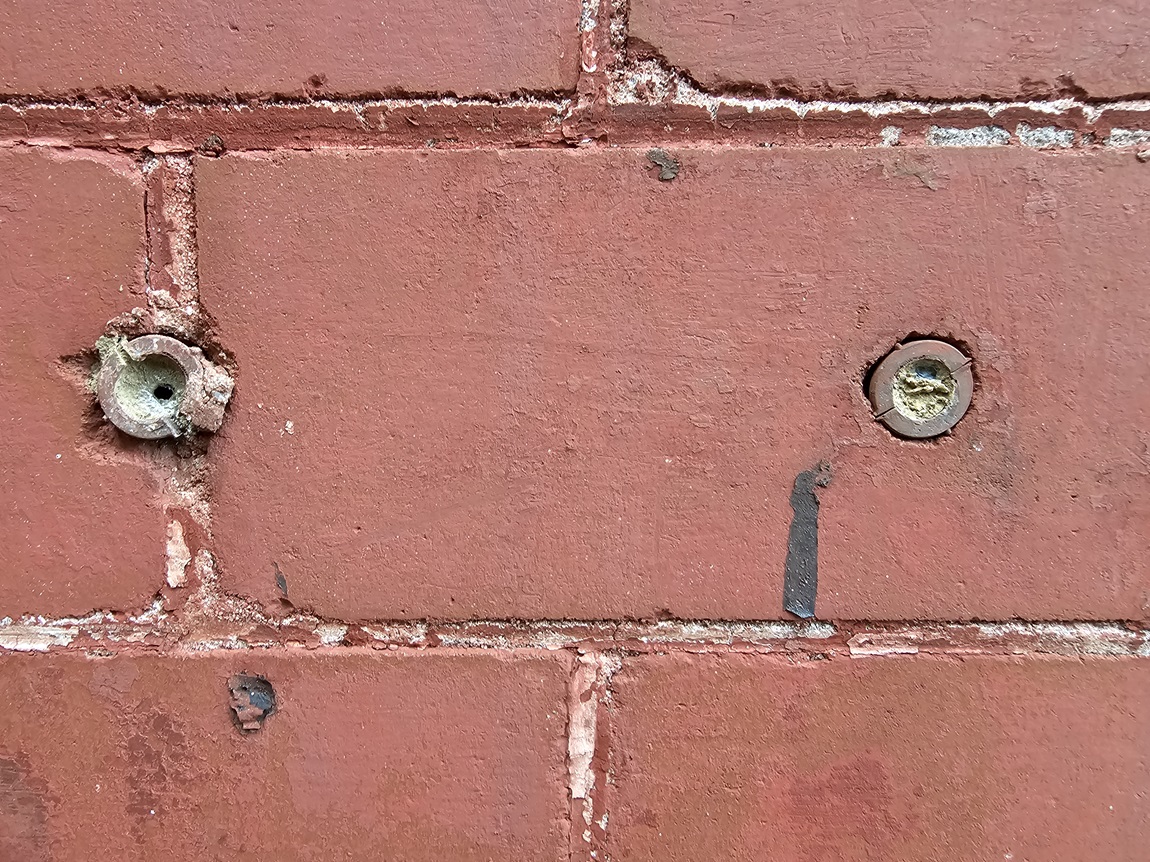
We’re only working on this building now and we’re not sure why people years ago installed the five screws shown in the picture below. You can see though that the lowest of those screws has already caused the brick to small. The edge of the brick is broken off at the location of the screw, from that point out to the corner of the building.
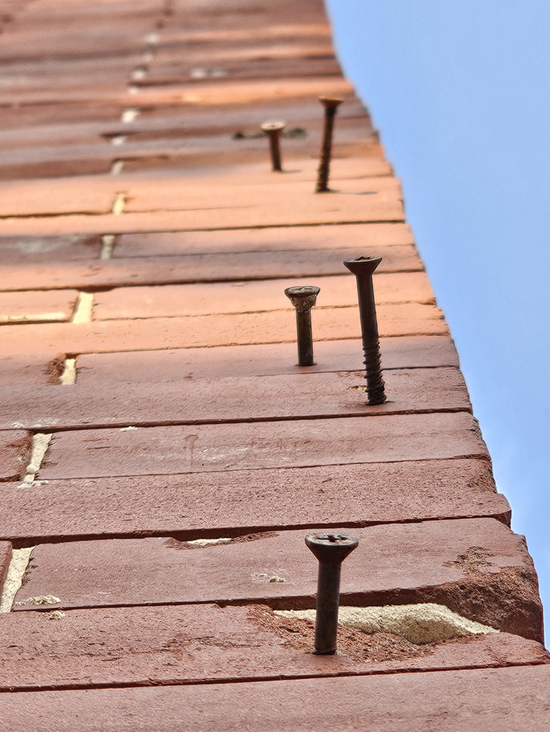
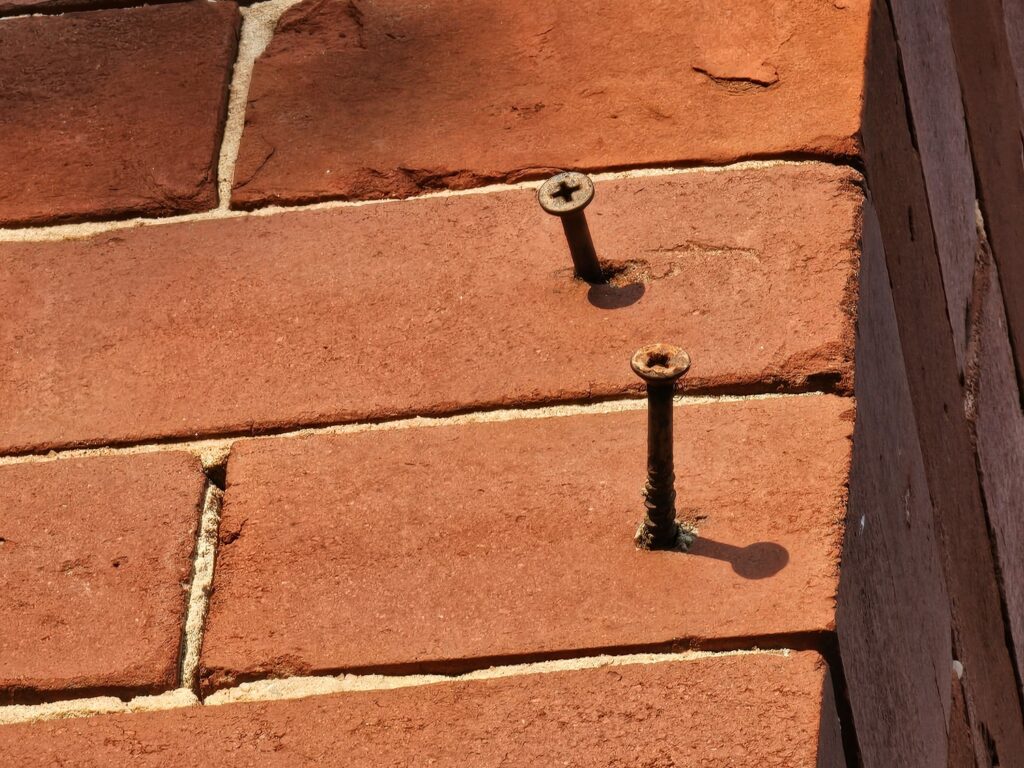
Compressive strength is the ability for a material to resist being squeezed together and tensile strength is basically the ability for material to resist the force of being stretched apart. Since bricks, particularly historic bricks, lack significant tensile strength, when people install screws are Fasteners into the face of a brick, it should be done near the dead center of that brick, not near the edge of the brick. In general though, it’s best if Fasteners are not installed inside of the face of a brick at all in most cases a layout of mounting of a device or element could simply be moved so that a Fastener or screw can be set into the mortar joint.
The mortar joint is often easier to prepare the a brick itself. We look at motor as if it’s almost sacrificial. It has a clear purpose, but mortar is also intended to be weaker than the bricks that it can deteriorate faster because it’s easier to repair mortar than it is to repair bricks. Replacing a brick, for example, is very expensive. Motor replacement such as the process of repointing or tuck pointing is also tedious and therefore expensive, but it’s much cheaper than replacing or repairing the bricks themselves.
If you are looking for a masonry restoration contractor that takes historic preservation seriously, reach out to us. Our company can help.
You can reach us by telephone at (202) 796-7644 and you can reach us by email from the contact form on our website at https://duponttuckpointingmasonrydc.com/contact-us/.




